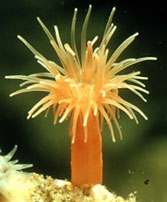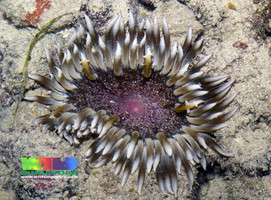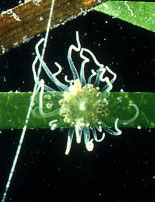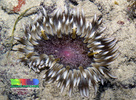Nynantheae
Characteristics
Actiniaria with a rounded or flat base with or without basilar muscles. Column smooth or with outgrowths of one sort or another, rarely (and then especially in the uppermost part) provided with ectodermal muscles. Sphincter absent or present, endodermal or mesogloeal. Tentacles simple or complex, commonly arranged in cycles, sometimes in radial rows. Siphonoglyphs usually attached to directives, rarely to non-directives, when directives are absent. Mesenteries as a rule arranged in cycles, commonly hexamerously. Secondary mesenteries always develop in exocoels. The pairs of non-directives consist of two mesenteries whose retractors face one another, rarely unpaired mesenteries occur. Mesenterial filaments always with ciliated tracts. Holotrichous nematocysts only exceptionally present, and never in the endoderm.References
Carlgren, O. 1949. A Survey of the Ptychodactiaria, Corallimorpharia and Actiniaria. Kungl. Svenska Vetenskapsakadamiens Handlingar, series 4, volume 1, number 1.
Title Illustrations

| Scientific Name | Phymanthus sp. |
|---|---|
| Location | Bukit Merah, Central Singapore |
| Specimen Condition | Live Specimen |
| Source | Branched sea anemone (Phymanthus sp.) |
| Source Collection | Flickr |
| Image Use |
 This media file is licensed under the Creative Commons Attribution-NonCommercial-NoDerivs License - Version 2.0. This media file is licensed under the Creative Commons Attribution-NonCommercial-NoDerivs License - Version 2.0.
|
| Copyright | © 2005 Ria Tan |
About This Page
The information provided on this page is based on Oscar Carlgren's 1949 catalog.Copyright © 1949 Swedish Academy of Sciences.
Please note that Carlgren's text contains a number of errors, and much of the information is now out of date. An update of the catalog is currently under preparation in Daphne Fautin's laboratory, and the results of this work will be incorporated in future versions of this page.
Keyboarding of Carlgren's catalog was done as part of a project to create an electronic database of the sea anemones of the world, funded by NSF Grant DEB9521819, awarded to Daphne G. Fautin. This grant is in the program Partnerships to Enhance Expertise in Taxonomy (PEET). Susanne Hauswaldt, Katherine Pearson, and April Wakefield-Pagels contributed to the keyboarding effort.
Correspondence regarding this page should be directed to Daphne G. Fautin at
Page copyright © 2000
All Rights Reserved.
Citing this page:
Tree of Life Web Project. 2000. Nynantheae. Version 01 January 2000 (temporary). http://tolweb.org/Nynantheae/17673/2000.01.01 in The Tree of Life Web Project, http://tolweb.org/












 Go to quick links
Go to quick search
Go to navigation for this section of the ToL site
Go to detailed links for the ToL site
Go to quick links
Go to quick search
Go to navigation for this section of the ToL site
Go to detailed links for the ToL site